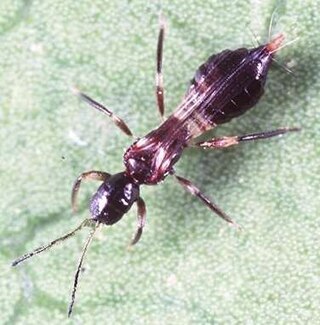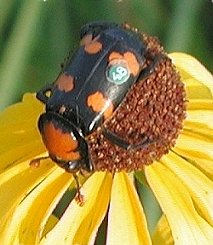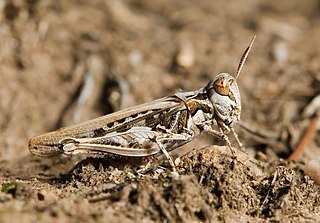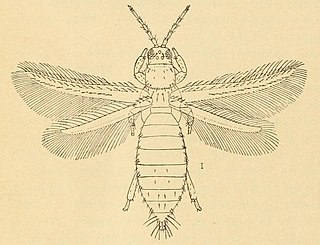
Ran is a 1985 epic action drama film directed, edited and co-written by Akira Kurosawa. The plot derives from William Shakespeare's King Lear and includes segments based on legends of the daimyō Mōri Motonari. The film stars Tatsuya Nakadai as Hidetora Ichimonji, an aging Sengoku-period warlord who decides to abdicate as ruler in favor of his three sons.

Franklinothrips is a genus of thrips with pantropical distribution.

Arla is a genus of moths in the family Gelechiidae.

Nicrophorini is a tribe of burying beetles or carrion beetles in the subfamily Silphinae. It was formerly treated as subfamily Nicrophorinae within family Silphidae, but this family was found to be nested in family Staphylinidae in phylogenetic analyses and Silphidae was reassigned as a subfamily Staphylinidae.

Austroicetes is a genus of grasshoppers in the subfamily Oedipodinae and family Acrididae. Members of the genus typically feed on grass and herbs.

Elenchus tenuicornis is an insect species in the genus Elenchus.
E. tenuicornis may refer to:

Toxoscelus is a genus of beetles in the family Buprestidae, containing the following species:
Paratrachys is a genus of "jewel beetles" in the subfamily Polycestinae and tribe Paratrachyini.

Lymexylon is a genus of beetles in the family Lymexylidae, containing the following species:
Mordellistena tenuicornis is a species of beetle in the genus Mordellistena of the family Mordellidae. It was described by Schilsky in 1899.

Asaperda is a genus of beetles in the family Cerambycidae, containing the following species:

Platystomos is a genus of beetles belonging to the family Anthribidae.

Heteromurus is a genus of slender springtails in the family Entomobryidae. There are at least three described species in Heteromurus.
Archaeorrhynchus is an extinct genus of weevil from the family Nemonychidae. It is known from the Callovian-Oxfordian Karabastau Formation in Kazakhstan. The type species, Archaeorrhynchus tenuicornis, was named in 1926. Two other species, A. tenuicornis and A. carpenteri, were described from the same locality.
Glenostictia is a genus of sand wasps in the family Crabronidae. There are more than 20 described species in Glenostictia.

Frankliniella is a genus of thrips belonging to the family Thripidae.

Leander is a genus of shrimp belonging to the family Palaemonidae.

Heterotemna is a genus of carrion beetles in the tribe Silphini. Species in this genus are native to the Canary Islands. It contains the following species:

Dicronocephalus is a genus of mostly Asian beetles erected by Frederick William Hope in 1831. It is placed in the tribe Goliathini and is typical of the subtribe Dicronocephalina Krikken, 1984.














